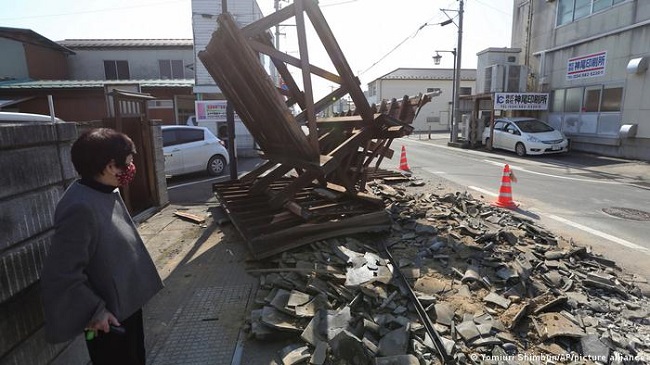An earthquake of magnitude 8.9 has struck northeastern Japan, making it one of the most powerful quakes in more than a century.
The earthquake’s epicentre was just 15 miles below the surface, yet it nonetheless generated a tsunami that was 23 feet high in Fukushima Prefecture and 13 feet high in neighbouring Iwate Prefecture. Similarly high waves (up to 13 feet) affected four more northern prefectures.

The Associated Press reports that 300 dead have washed up on a beach near Sendai, and dramatic overhead photographs across Miyagi, which is primarily flat farming country, show a dark, debris-filled wave of water and muck engulfing everything in its path, from buildings to automobiles and highways.
Read Also:
- Markelle Fultz Gives Glimpse Of What Magic Can Expect
- Kelsea Ballerini’s ‘Untouched’ Underwear Photos
Contents
151 People have Lost their Lives. Likewise, 547 People Went Missing and were Reported.
The government of Japan reacted swiftly, claiming this is one of the worst natural disasters in the country’s history. Naoto Kan, the Prime Minister of Japan, issued a statement urging everyone to relax and work together.
Assuring the Japanese people that “we will protect their safety and work to remain cautious and be alert about keeping tuned in to television and radio information,” he said. The citizens of Japan, we implore you, please be calm.
Timing of the Quake
The timing of the quake is especially inconvenient for Kan, as it occurred when lawmakers were debating an illicit donations controversy. The earthquake could prove to be his saviour if he is able to successfully steer the country through the crisis.
Several nations outside of Japan were on high alert as well. In addition to Indonesia, Hawaii, Australia, and New Zealand, the countries of Mexico, Chile, and Peru have also received tsunami warnings from the Pacific Tsunami Warning Center in Honolulu.
Alert From the Centre
Japan, Russia, Marcus Island, Northern Mariana Islands, Guam, Wake Island, and Taiwan were all included in an earlier alert from the centre.
Tragic recollections of the big Asian tsunami of December 24, 2004, which killed hundreds of thousands, were brought back to mind by the tsunami.
Tokyo, the capital of Japan, located roughly 186 miles from the epicentre, felt a significant tremor.
“Over there, you can see a row of apartment buildings. It’s swinging horribly, to the point where it appears small, as if a photograph of it was processed using tilt shift technology “live-blogged one woman from Tokyo.
People Cried, And Others Hugged.
I just can’t wrap my head around the idea of a building acting like that. Massive crowds gathered outside of Tokyo’s major stations after the quake, when trains and subways stopped running. In disbelief, onlookers stopped what they were doing and stood. Some people cried, and others hugged.
During the Quake
During the quake, Shibuya, where I live, came to a complete standstill. When his cab started shaking, one cab driver informed me he assumed he had a flat tyre. While trying to reach his family in the north, he nervously remarked, “That must have been the biggest one I’ve ever felt.” Then I saw a big queue developing near a single public telephone.
A strange sight in today’s smartphone-obsessed culture, it only served to reinforce my worst suspicions that landlines remain the only truly reliable means of communication. When I stepped out onto the sidewalk, I noticed a sizable crowd waiting in line at a nearby convenience store to buy food, water, and other needs. The store manager warned that they are running out on various items, including mobile phone chargers.
Thousands of People Stuck in City
Within days after the quake, the power to more than four million buildings was reportedly cut in Tokyo and the surrounding area. Subway and train service has been cut off, leaving hundreds of thousands of people stuck in a city of 13 million.
Even though no substantial damage has been recorded so yet, the East Japan Railway Company has halted all train operations, including the Shinkansen bullet trains.
Tokyo Metro Subway System has Likewise Stopped Running
The Tokyo Metro subway system has likewise stopped running. In order to ensure the safety of all tunnels, the company says it will take some time. The Transport Ministry said that both Narita and Haneda airports in Tokyo had closed its runways, while the Nuclear Power Security Agency stated that all five nuclear power reactors in the region’s northeast had been evacuated.
Read Also:
Watching Live Footage of the Devastating Tsunami
I remember standing in a group of strangers in front of a TV in an electronics store, watching live footage of the devastating tsunami that hit northern Japan, wiping out thousands of homes, rice paddies, and escape vehicles. It was the first time any of us had ever seen a natural calamity of that magnitude in Japan. What do you make of this?
Is it the “big one” we’ve been waiting for? My curiosity got the better of me, so I inquired. As an aftershock rumbled beneath our feet, a young woman feared, “Maybe there’s more to come.” It seems likely that we have not seen anything close to the entire magnitude of the destruction.






























